
Year 972 (CMLXXII) was a leap year starting on Monday of the Julian calendar.

Vsevolod I Yaroslavich, ruled as Grand Prince of Kiev from 1078 until his death.

Vladimir I Sviatoslavich or Volodymyr I Sviatoslavych, nicknamed the Great, was Prince of Novgorod, Grand Prince of Kiev, and ruler of Kievan Rus' from 980 to 1015. Several scholars refer to him as Volodimer I or Volodimir I, and his descendants as Volodimerovichi, while the Eastern Orthodox Church canonised him as Saint Vladimir.
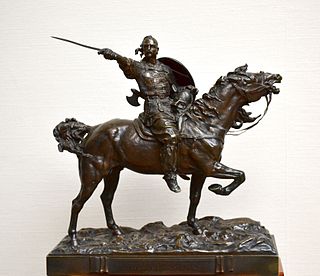
Sviatoslav or Syatoslav I Igorevich was Grand Prince of Kiev known for his persistent campaigns in the east and south, which precipitated the collapse of two great powers of Eastern Europe, Khazaria and the First Bulgarian Empire. He conquered numerous East Slavic tribes, defeated the Alans and attacked the Volga Bulgars, and at times was allied with the Pechenegs and Magyars (Hungarians).
The Grand Prince of Kiev was the title of the monarch of Kievan Rus', residing in Kiev from the 10th to 13th centuries. In the 13th century, Kiev became an appanage principality first of the grand prince of Vladimir and the Mongol Golden Horde governors, and later was taken over by the Grand Duchy of Lithuania.

Igor Rurikovich was a Rurikid ruler of Kievan Rus' from 912 to 945.

Yaropolk I Sviatoslavich was a young and rather enigmatic ruler of Kiev between 972 and 980. He was the oldest son of Svyatoslav. His royal title is traditionally translated as "Prince".

Sviatopolk I Vladimirovich was the Kniaz' (Turov) of Turov (988–1015) and Velykyi Kniaz or Grand Prince of Kiev (1015–1019) whose paternity and guilt in the murder of his brothers are disputed.
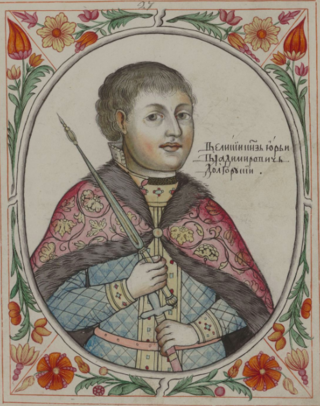
Yuri I Vladimirovich, commonly known as Yuri Dolgorukiy or the Long Arm was a Rurikid prince. Noted for successfully curbing the privileges of the landowning boyar class in Rostov-Suzdal and his ambitious building programme, Yuri transformed this principality into the independent power that would evolve into early modern Muscovy. Yuri Dolgorukiy was the founder of the Yurievichi dynasty, a branch of the Monomakhovichi.

Iziaslav Yaroslavich was a Kniaz' (Prince) of Turov and Grand Prince of Kiev from 1054.

The Drevlians or Derevlianians were a tribe of Early East Slavs between the 6th and the 10th centuries, which inhabited the territories of Polesia and right-bank Ukraine, west of the eastern Polans and along the lower reaches of the rivers Teteriv, Uzh, Ubort, and Stsviha. To the west, the Drevlians' territories reached the Sluch River, where the Volynians and Buzhans lived. To the north, the Drevlians' neighbors were the Dregovichs.
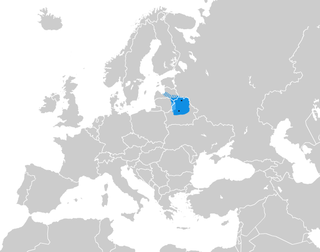
The Principality of Polotsk, also known as the Duchy of Polotsk or Polotskian Rus', was a medieval principality of the Early East Slavs. The origin and date of state establishment is uncertain. Chronicles of Kievan Rus' mention Polotsk being conquered by Vladimir the Great, and thereafter it became associated with Kievan Rus' and its ruling Rurik dynasty.
Sveneld is a semi-legendary 10th-century Varangian warlord in the service of Sviatoslav I and his family. Although he seems to have been the richest and the most influential Rus' leader after the ruling prince, his relation to the House of Rurik, if it existed, has not been positively established. Most of information about Sveneld is scarce.

The Caspian expeditions of the Rus' were military raids undertaken by the Rus' between the late 9th century and c. 1041 on the Caspian Sea shores, of what are nowadays Iran, Dagestan, and Azerbaijan. Initially, the Rus' appeared in Serkland in the 9th century traveling as merchants along the Volga trade route, selling furs, honey, and slaves. The first small-scale Viking raids took place in the late 9th and early 10th century. The Rus' undertook the first large-scale expedition in 913; having arrived on 500 ships, they pillaged in the Gorgan region, in the territory of present-day Iran, and more to the west, in Gilan and Mazandaran, taking slaves and goods. On their return, the northern raiders were attacked and defeated by the Khazars in the Volga Delta, and those who escaped were killed by the local tribes on the middle Volga.
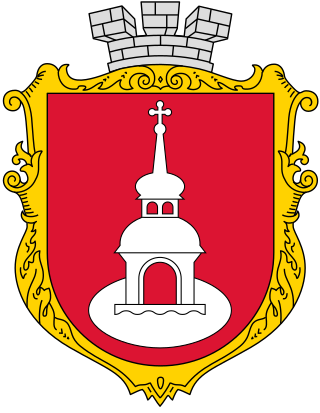
The Prince of Pereiaslavl was the kniaz of the Rus Principality of Pereiaslavl, a lordship based on the city of Pereiaslavl on the Trubezh river and straddling extensive territory to the east in what are now parts of Ukraine. It lay on Rus civilization's southern frontier with the steppe.
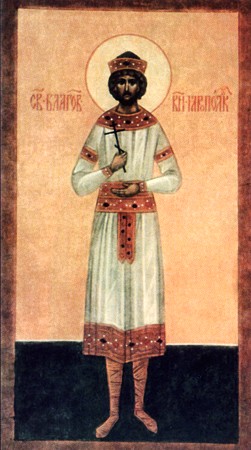
Yaropolk Iziaslavich or Yaropolk Iziaslavych was a Kniaz (prince) during the eleventh-century in the Kievan Rus' kingdom and was the King of Rus (1076–1087). The son of Grand Prince Iziaslav I of Kiev (Kyiv) by a Polish princess named Gertruda, he is visible in papal sources by the early 1070s but largely absent in contemporary Rus sources until his father's death in 1078. During his father's exile in the 1070s, Yaropolk can be found acting on his father's behalf in an attempt to gain the favor of the German emperors and the papal court of Pope Gregory VII. His father returned to Kiev in 1077 and Yaropolk followed.

Kievan Rus', also known as Kyivan Rus', was a state and later an amalgam of principalities in Eastern and Northern Europe from the late 9th to the mid-13th century. Encompassing a variety of polities and peoples, including East Slavic, Norse, and Finnic, it was ruled by the Rurik dynasty, founded by the Varangian prince Rurik. The modern nations of Belarus, Russia, and Ukraine all claim Kievan Rus' as their cultural ancestor, with Belarus and Russia deriving their names from it. At its greatest extent in the mid-11th century, Kievan Rus' stretched from the White Sea in the north to the Black Sea in the south and from the headwaters of the Vistula in the west to the Taman Peninsula in the east, uniting the East Slavic tribes.
Vladimir III Svyatoslavich was a Rus' prince. His baptismal name was Boris. He was prince of Gomiy (1164–?), of Novgorod, of Karachev (1194–?), and probably of Novgorod-Seversk (1198–1200).

The Principality of Turov, also called Principality of Turov and Pinsk or Turovian Rus', was a medieval East Slavic principality and important subdivision of Kievan Rus' since the 10th century on the territory of modern southern Belarus and northern Ukraine. Princes of Turov often served as the Grand Princes of Rus early in 10th-11th centuries. The principality's capital was Turov and other important cities were Pinsk, Mazyr, Slutsk, Lutsk, Berestia, and Volodymyr.
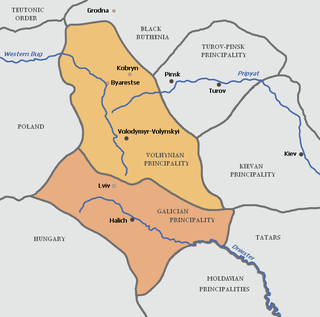
The Principality of Volhynia was a western Kievan Rus' principality founded by the Rurik dynasty in 987 centered in the region of Volhynia, straddling the borders of modern-day Ukraine, Belarus, and Poland. From 1069 to 1118, it belonged to Izyaslavichi who primarily ruled from Turov. After losing Turov to Monomakhovichi in 1105, the descendants of Iziaslav Yaroslavovich for a few years continued to rule in Volhynia. From 1154 to 1199, the Principality was referred to as the Principality of Volodymyr when the Principality of Lutsk (1154–1228) was separated.

















